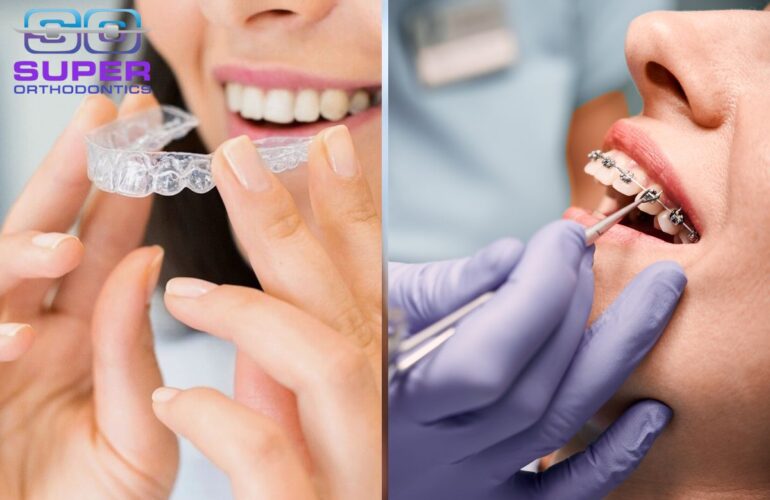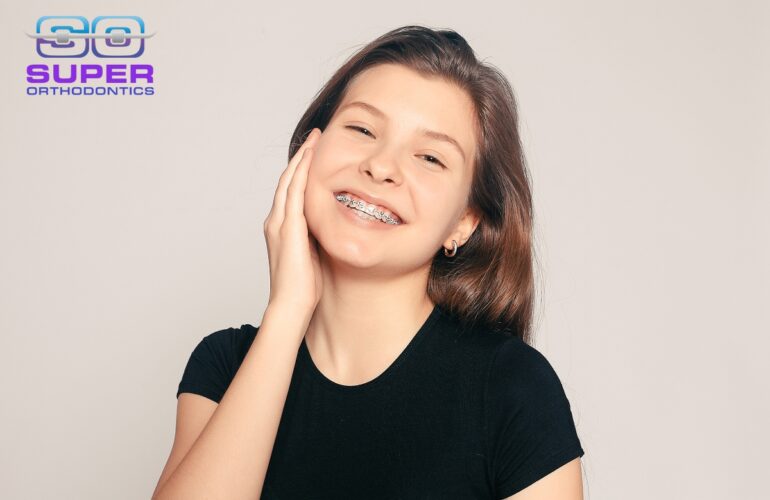Early orthodontic treatment can set the foundation for a lifetime of healthy, straight teeth. Invisalign First is a clear aligner system designed specifically for children between the ages of 6 and 10. While it offers a comfortable and discreet alternative to braces, there are important factors to consider before choosing Invisalign First for your child. This guide will explore the benefits, potential challenges, and situations where traditional braces might be a better option.
What Is Invisalign First?
Invisalign First uses custom-made, clear plastic aligners to correct early dental issues in children. It is part of a Phase 1 treatment, which addresses problems like crowding, spacing, and jaw misalignment before all permanent teeth erupt. The aligners gently shift teeth and guide jaw development, creating space for incoming adult teeth and addressing functional issues early.
Who Can Benefit from Invisalign First?
Children aged 6 to 10 years with the following dental issues may benefit from Invisalign First:
-
- Crowding or Spacing Issues: Helps align teeth when there is too much or too little space.
- Crossbites or Open Bites: Corrects bite problems that can affect chewing and speech.
- Jaw Expansion Needs: Guides the development of a wider jaw to accommodate permanent teeth.
- Habit Correction: Manages thumb-sucking or tongue-thrusting habits that affect dental alignment.
Benefits of Invisalign First
-
- Aesthetic Appeal: The aligners are clear and less noticeable than traditional braces, which can boost a child’s confidence.
- Comfort: Made from smooth plastic, Invisalign First aligners cause less irritation to the gums and cheeks compared to braces.
- Removable: Kids can remove the aligners for eating, brushing, and flossing, promoting better oral hygiene.
- No Food Restrictions: Children can continue enjoying their favorite foods without worrying about damaging brackets or wires.
- Fewer Emergency Visits: No broken wires or brackets mean fewer trips to the orthodontist for repairs.
Cautions and Potential Challenges with Invisalign First
While Invisalign First offers many advantages, there are some important considerations and challenges:
-
- Compliance Is Key:
The aligners must be worn 20-22 hours a day to be effective. Younger children may forget or resist wearing them, leading to slower or incomplete treatment. - Lost or Damaged Aligners:
Kids can misplace or damage their aligners, which may delay treatment or increase costs. - Not Suitable for Severe Cases:
Invisalign First may not be effective for complex orthodontic issues, such as severe bite misalignments or significant jaw discrepancies. - Discomfort During Adjustments:
Although less painful than braces, aligners can still cause discomfort when switching to a new set, as teeth are gradually shifting. - Monitoring Oral Hygiene:
While aligners can be removed for brushing and flossing, parents must ensure children clean their teeth thoroughly to avoid plaque buildup and cavities.
- Compliance Is Key:
When Braces Might Be a Better Option
In some cases, traditional braces may be more effective or practical than Invisalign First. Here’s why:
-
- Severe Orthodontic Issues: Braces are better suited for complex cases, such as extreme crowding, severe bite problems, or jaw misalignments.
- No Compliance Concerns: Braces are fixed to the teeth, so there’s no need to worry about whether your child is wearing them as instructed.
- Durability: Braces are more durable and less likely to be damaged, making them a good option for active kids who might lose or break aligners.
- More Controlled Tooth Movement: Braces allow orthodontists to apply more precise pressure, which can be beneficial in complex cases.
- Cost Considerations: While the costs of Invisalign First and braces are generally comparable, repeated replacement of lost aligners can make Invisalign more expensive.
Invisalign First vs. Braces: Pros and Cons
| Feature | Invisalign First | Braces |
| Appearance | Clear, nearly invisible aligners | Metal brackets and wires, more noticeable |
| Comfort | Smooth plastic, less irritation to cheeks and gums | Wires and brackets may cause discomfort or sores |
| Removability | Removable for eating and cleaning | Fixed, no risk of losing appliances |
| Compliance | Requires disciplined wear (20-22 hours/day) | Always in place, no compliance concerns |
| Hygiene | Easier to brush and floss normally | Requires special tools for cleaning around brackets |
| Dietary Restrictions | No restrictions | Must avoid sticky, hard, or chewy foods |
| Cost | Similar, but aligners may add costs if lost | Generally stable, unless repairs are needed |
| Treatment for Complex Issues | Limited for severe cases | Effective for all levels of complexity |
| Activity Limitations | None, aligners can be removed for sports | Mouthguards needed for contact sports |
Is Invisalign First Right for Your Child?
Consider Invisalign First If:
-
- Your child has mild to moderate orthodontic issues.
- They are responsible and can commit to wearing aligners consistently.
- Aesthetic concerns are a priority for your child.
Consider Braces If:
-
- Your child has complex orthodontic issues that require more precise treatment.
- They might struggle with keeping track of removable aligners.
- Durability and low maintenance are important.
Why Early Orthodontic Treatment Matters
Starting orthodontic treatment early can prevent more serious issues from developing later. By addressing problems while the jaw is still growing, orthodontists can guide the development of teeth and bones, potentially reducing the need for invasive procedures in the future.
Final Thoughts
Invisalign First offers a modern, comfortable, and discreet option for early orthodontic treatment. However, it requires a high level of commitment and may not be suitable for every child. If your child needs early intervention, consult with a board-certified orthodontist to discuss whether Invisalign First or braces would be the best choice. By making an informed decision, you can set your child on the path to a healthy, confident smile.





